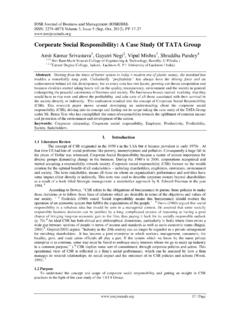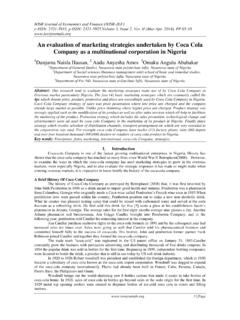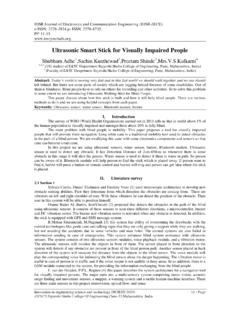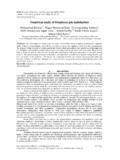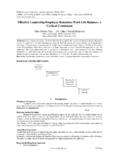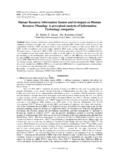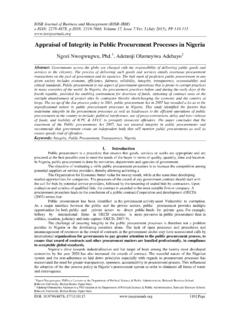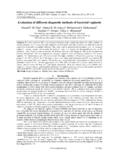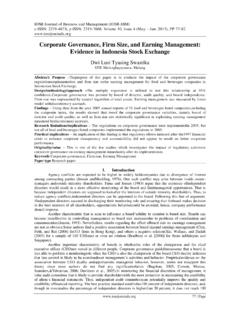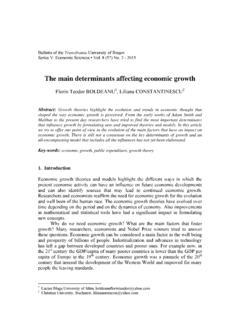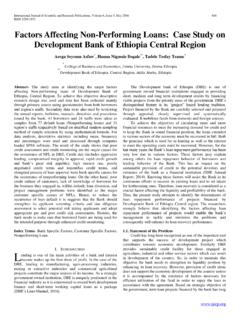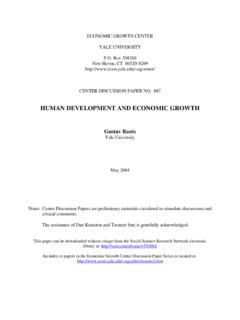Transcription of FACTORS AFFECTING THE CAPITAL STRUCTURE
1 IOSR Journal of Business and Management (IOSR-JBM) e-ISSN: 2278-487X, p-ISSN: 2319-7668. Volume 18, Issue 10. Ver. VII (October. 2016), PP 83-88 DOI: 83 | Page FACTORS AFFECTING the CAPITAL STRUCTURE in Textile and Garment Listed in Indonesia Stock Exchange Cinde Ririh Windayu Study Program of Economics Education, Graduate Program of Universitas Negeri Malang Abstract: The purpose of this study was to determine and analyze the influence simultaneously and partially on these FACTORS . The data used is secondary data. The study population was textile and garment companies listed in Indonesia Stock Exchange in 2004-2008. Sampling was done by purposive sampling method and generated eight qualified company. The data analysis used is multiple linear regressions test. The results showed: (1) size of the company, the characteristics / type of industry, sales growth, asset STRUCTURE , operating leverage, Non-Debt Tax Shield and profitability simultaneously affect the CAPITAL STRUCTURE , but other FACTORS greater influence, among others : economic conditions, political, social, state security unfavourable.
2 In the company it is a management attitude, the attitude of lenders, market conditions, the company's internal conditions, and financial flexibility. (2) The size of the company, industry characteristics, sales growth, asset STRUCTURE and profitability is partially effecting on the CAPITAL STRUCTURE , while the operating leverage and Non- debt Tax Shield has no effect on the CAPITAL STRUCTURE . Leverage operation has no effect because the sales from year to year are relatively the same, which is sometimes up and sometimes down. This means that funding by using the fixed costs do not affect the CAPITAL STRUCTURE decisions made by management. While Non-Debt Tax Shield has no effect because the textile and garment companies have total assets remained low so it does not obtain a tax advantage in the form of depreciation expense / depreciation can be deducted in calculating the amount of tax payable. This indicates that the value of depreciation and amortization, the company is not meaningful enough to add cash flow of the company, so it does not count towards the reduction of corporate debt portion.
3 Keywords: Company Size, Characteristic / Type of Industry, Sales Growth, Asset STRUCTURE , Operating Leverage, Non-Debt Tax Shield, Profitability, CAPITAL STRUCTURE . I. Introduction In developing business or expansion, in general, companies need of financial resources. Fulfilments of these funds come from internal resources or external sources. Therefore, financial managers with regard to the use of CAPITAL costs (cost of CAPITAL ) and other costs need to determine the CAPITAL STRUCTURE in an effort to determine whether the financing needs are filled with their own CAPITAL or filled with loan CAPITAL . In conducting the funding decisions, companies also need to consider and analyze the combination of economical sources of funds to finance investment requirements and business activities (Riyanto, 2001). CAPITAL STRUCTURE theory explaining whether there is influence changes in CAPITAL STRUCTURE to the company's value, if investment decisions and dividend policy are held constant.
4 In other words, if the company replaces partly some of their own CAPITAL to the debt (or vice versa), whether the stock price will change, if the company does not change other financial decisions. In other words, if the CAPITAL STRUCTURE changes do not alter the value of the company, meaning that there is no best CAPITAL STRUCTURE . All CAPITAL STRUCTURE is good, but if by changing the CAPITAL STRUCTURE turned out to be the value of the company is changed, it will obtain the best CAPITAL STRUCTURE . CAPITAL STRUCTURE that maximizes the value of company or stock prices is the best CAPITAL STRUCTURE (Husnan and Pudjiastuti, 1994). The textile industry starting from yarn manufacturing industry (spinning), cloth-making industry (weaving and knitting), and refinement industry (finishing) to the apparel industry (garments). Raw materials textile industry can use either natural fibbers from plant fibbers such as cotton fibbers, animal fibbers such as wool, silk, or from other synthetic materials such as nylon, polyester, acrylic and others.
5 In Indonesia's, textile industry is very varied both in terms of production scale (small-scale, medium to large scale) with technology from labour-intensive to CAPITAL -intensive, as well as variations in the process including the spinning process, the process of weaving / knitting, the refinement process until the process apparel. Many factories are just doing some these processes, but there is also an integrated factory starting from yarn making up the refinement process is even equipped with a process of making garments (Winiarti, 2003). The existence of the textile industry has a very important role in the economic development in Indonesia. The textile industry is labour-intensive industries (Labour Intensive) that absorb labour in high enough quantities, about 4 million to 5 million people (Journal of Indonesian CAPITAL Market 1998). Company textiles and garments increasingly difficult to obtain additional CAPITAL or new CAPITAL to run it s a business activity.
6 This company is funded from the source of the loan so that decreased performance. Needed revamping the company's CAPITAL STRUCTURE in order to be healthy performance and the company is able to survive. Companies that want to FACTORS AFFECTING the CAPITAL STRUCTURE in Textile and Garment Listed in Indonesia Stock Exchange DOI: 84 | Page survive must have an optimal CAPITAL STRUCTURE . In reality, it is difficult for companies to determine the best CAPITAL STRUCTURE in an appropriate composition of spending. Inequality CAPITAL STRUCTURE that rests on the debt becomes worse when the load becomes high interest and depreciation of the Rupiah. This is evident from a report on JSX Statistics 4 th Quarter 2004, 2005, 2006, 2007, and 2008 on the average ratio of comparison between total debt to own equity (Debt To Equity Ratio / DER) in the textile and garment companies listed on the Indonesia Stock Exchange, namely: in 2004 about 24 textile and garment companies listed on the Indonesia Stock Exchange has DER ratio of In 2005 about 23 textile and garment companies listed on the Indonesia Stock Exchange has DER ratio of In 2006 about 21 textile and garment companies listed on the Indonesia Stock Exchange has DER ratio was In 2007 about 23 textile and garment companies listed on the Indonesia Stock Exchange has DER ratio of And in 2008 about 23 textile and garment companies listed on the Indonesia Stock Exchange has DER ratio of (JSX Statistics 4 th Quarter, 2004, 2005, 2006, 2007, and 2008).
7 In this situation the financial manager's main task is to continue efforts to resolve the issue. And of the problems mentioned above, the researcher are interested in doing research on textile and garment companies are expected to avoid inequality of its CAPITAL STRUCTURE and seeking to achieve an optimal balance in the use of debt and equity in determining the CAPITAL STRUCTURE , so that the CAPITAL cost of the average company can be minimized and further increasing the company's value. Relating to various circumstances, it is known variables AFFECTING CAPITAL STRUCTURE includes a variable sized companies (firm size), the characteristics / type of industry (industry classification), sales growth (growth opportunities), the STRUCTURE of assets (tangibility assets), operating leverage (operating leverage) , Non-Debt Tax Shield (NDTS), and profitability (profitability) (ROE).Titman and Wessels research (1988) entitled "Determinant of CAPITAL STRUCTURE Choice".
8 FACTORS AFFECTING the CAPITAL STRUCTURE as the dependent variable is the independent variable as follows: (1) Collateral Value Of Assets (value line of assets), (2) Non-Debt Tax Shield (NDTS), (3) Growth (growth), (4 ) uniqueness (uniqueness), (5) industry Classification (type of industry), (6) firm size (the size of the company), (7) Volatility, and (8) profitability (profitability). By using data analysis tools LISREL (development of model STRUCTURE linear) obtained result: (1) there are three FACTORS that partial effect on the CAPITAL STRUCTURE , the uniqueness of the product, profitability, and the size of the company, (2) the uniqueness product factor and profitability negatively influence to CAPITAL STRUCTURE , (3) the size of the company's positive effect on the CAPITAL STRUCTURE . Bauer (2004) conduct research entitled "Determinants of CAPITAL STRUCTURE Empirical Evidence from the Czech Republic . FACTORS that affect the CAPITAL STRUCTURE as the dependent variable is the independent variable as follows: (1) Size (the size of the company), (2) Profitability (profitability), (3) Tangibility ( STRUCTURE of assets), (4) Growth Opportunities (growth opportunities), (5) tax (tax), (6) Non-Debt tax Shield (NDTS), (7) Volatility, (8) industry Classification (type of industry).
9 Its positive effect to CAPITAL STRUCTURE is the size of the company, and taxes. The negative effect on profitability, asset STRUCTURE , growth opportunities and Non-Debt Tax Shield (NDTS), while volatility has no effect. On this type of industry was difficult to calculate. Bevan and Danbolt (2004), conduct research entitled "Testing for inconsistencies in the Estimation of UK CAPITAL STRUCTURE Determinants". FACTORS AFFECTING the CAPITAL STRUCTURE (the dependent variable) are: (1) The Natural logarithm of Sales (Firm Size) (company size), (2) Profitability (profitability), and (3) Tangibility (asset STRUCTURE ). The analysis tool used is regression: ordinary squares (OLS) and fixed effects panel estimation model. The results of this study are: (1) Simultaneously significant effect between firm size, profitability, and asset STRUCTURE to the CAPITAL STRUCTURE , (2) Partially: company size and STRUCTURE of assets is positively correlated to the CAPITAL STRUCTURE , profitability negatively correlate, growth rates are not correlated to the CAPITAL STRUCTURE .
10 Research Baral (2004) entitled "Determinants of CAPITAL STRUCTURE : A Case Study of Listed Companies of Nepal" revealed the following things. FACTORS AFFECTING the CAPITAL STRUCTURE (the dependent variable) are independent variables: (1) Size of a Firm (company size), (2) Growth Rate (rate of growth), (3) Business Risk (business risk), (4) Profitability (profitability), (5) dividend payout (dividend payout ratio), (6) debt Service Capacity (capacities capability repayment of debt), and (7) operating leverage (operating leverage). The analysis tool used is multiple regression models. The results of the research are (1) simultaneously significant effect between firm size, growth, business risk, profitability, dividend payout ratio, the capacity capability repayment of debt, and operating leverage, (2) Partially: company size, growth, and profitability significantly influence CAPITAL Abor (2005) entitled "The Effect of CAPITAL STRUCTURE on Profitability: An Empirical Analysis of Listed Firms in Ghana".
